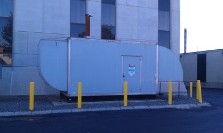Specialty
Air Quality
SECTOR
Commercial
TYPE
Permitting / Compliance
CLIENTELE
Private Sector
TIMESPAN
2013LOCATION
Lowell, MA
Project Number:
3788Verizon Emergency Generator
SERVICE:
Air Modeling Analysis
DESCRIPTION:
Tech performed air dispersion and noise impact analyses for the replacement of the Verizon emergency generator. There was a concern that the new generator's stack would be an exceedance under the National Ambient Air Quality Standards (NAAQS) and out of compliance with the MassDEP air quality regulations. Tech performed an analysis that included the following: performing BPIP building downwash analysis with cavity calculations, analysis and selection of background air concentrations from representative MassDEP monitoring stations near the site, and selection of receptor grid network including nearby sensitive receptors and building air intakes. All air modeling was conducted for nitrogen dioxide (NO2), sulfur dioxide (SO2), carbon monoxide (CO) and fine and coarse particulate matter. From the analysis, Tech was able to conclude that the new generator, with a 10-foot stack height would meet all NAAQS, and therefore, would comply with the MassDEP stack height requirements. The purpose of this noise study was to determine if the proposed emergency generator will comply with the MassDEP Noise Policy. Tech added the adjacent existing generator and rooftop chiller to our noise modeling analysis to assess the potential cumulative sound impacts. The results of the modeling analysis demonstrated that the Verizon emergency generator will fully comply with the MassDEP Noise policy at all noise-sensitive locations. Similarly, the results of cumulative modeling analysis demonstrated that the new and existing emergency generators and the new rooftop chiller operating simultaneously will also fully comply with the MassDEP Noise policy at all noise-sensitive locations.

